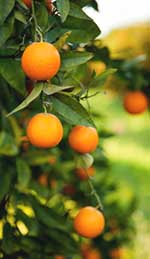 One of the most celebrated fruits in the world, sweet oranges account for up to 70% of all citrus species cultivated today. Sweet orange essential oil is also one of the most versatile essential oils, with an extensive list of household and medicinal uses. Produced as a byproduct of pressing orange juice, sweet orange essential oil can be used as a household detergent (especially on treated wood), hand cleanser, fragrance, and in aromatherapy. Sweet orange oil is a yellow-orange to dark orange mobile liquid with an unmistakable sweet citrusy fragrance. It blends well with lavender, myrrh, other citrus oils such as lemon and neroli, and spice oils such as clove, cinnamon and nutmeg.
One of the most celebrated fruits in the world, sweet oranges account for up to 70% of all citrus species cultivated today. Sweet orange essential oil is also one of the most versatile essential oils, with an extensive list of household and medicinal uses. Produced as a byproduct of pressing orange juice, sweet orange essential oil can be used as a household detergent (especially on treated wood), hand cleanser, fragrance, and in aromatherapy. Sweet orange oil is a yellow-orange to dark orange mobile liquid with an unmistakable sweet citrusy fragrance. It blends well with lavender, myrrh, other citrus oils such as lemon and neroli, and spice oils such as clove, cinnamon and nutmeg.
The sweet orange (Citrus sinensis) is likely a hyrbid of the tangerine and pomelo, two other citrus species. Native probably to Southeast or East Asia, the sweet orange tree is a small evergreen with white flowers; the round fruit has a bright to dark orange peel. Orange cultivation may date as far back as 2500 BC in China, and there are now many varieties of orange and orange hybrid, including the blood orange, tangelo, bitter orange, navel, and Valencia orange. While historians believe the bitter orange was known in Southern Europe since the Crusades of the 1100s—where it was used for medicinal purposes—the sweet orange did not arrive in Europe until the late 15th or 16th century, through trade with the Middle East. Sweet oranges were considered a luxury item in the 1500s, and rich nobles would grow them in greenhouses called orangeries. Spanish colonists later brought the first oranges to the New World via Hispañiola and other Caribbean islands. Today, Brazil, California and Florida produce the most oranges for the worldwide produce market [1].
The simplest way to use oranges is simply to eat them fresh! People also love squeezing orange pulp to make juice, as well as grating the rind—called the zest—to flavor baked goods, liqueurs and savory dishes. In the centuries before refrigeration, Spanish, Portuguese, and Dutch sailors planted orange groves along their trade routes so they could harvest the vitamin C-rich fruits as a defense against scurvy. Even today, in situations where the nutritional value of food must be maximized while generating a minimum of food waste, oranges play a crucial role: though not as tasty as the pulp, submarine crews will often eat orange peels on long voyages [1].
The uses of sweet orange essential oil are almost as various as the uses of the fresh fruit. As a cleanser, sweet orange oil can be added to water and used to wash down surfaces such as kitchen and bathroom counters, sinks, and toilets, where it acts as a strong natural antiseptic [2]. Adding a small bit of orange oil or lemon oil to a wooden counter or cutting board can also revitalize wood that has been stained with food, ink or coffee residues.
Medicinally, sweet orange essential oil has both mild stimulant and sedative qualities on different organ systems: inhaled or applied via massage, it can boost sluggish digestion and be helpful in combating indigestion, flatulence, or lack of appetite, and may also stimulate the lymphatic system [3]. Conversely, sweet orange oil may also act as a mild nerve sedative, promoting calmness while also lifting the mood [4]. It has noted benefits for the skin because it supports the formation of collagen, the connective tissue within cells, and can also help the body get rid of excess fluid by acting as a mild diuretic [4]. Besides its direct antiseptic action on infections such as the common cold, sweet orange oil helps stimulate the immune system to stave off opportunistic illnesses [5].
If you choose to work with sweet orange essential oil in a massage blend, be sure to wait at least 24 hours before exposing treated skin to sunlight to prevent a possible photosensitizing reaction. Or simply diffuse the fruity, refreshing scent of orange oil into your living room or bathroom to perk up the senses and energize the mind with every breath.
REFERENCES
1. “Orange (fruit)”. Wikipedia. Accessed May 13th, 2014. http://en.wikipedia.org/wiki/Orange_(fruit).
2. Dabbah, Roger, VM Edwards and WA Moats. 1970. “Anti-microbial action of citrus fruit oils on selected food-borne bacteria.” Applied and Environmental Microbiology 19 (1): 27-31.
3. Morton, Julia F. 1987. “Orange: Medicinal Uses” In: Fruits of Warm Climates pp 134-142. http://www.hort.purdue.edu/newcrop/morton/orange.html#Food%20Uses.
4. “Health Benefits of Orange Essential Oil.” Organic Facts. Accessed May 13th, 2014. http://www.organicfacts.net/health-benefits/essential-oils/orange-essential-oil.html.
5. “Sweet Orange Essential Oil Uses”. Naturally Healthy Families. Last modified October 11th, 2011. https://naturallyhealthyfamilies.wordpress.com/tag/sweet-orange-essential-oil-uses/.
